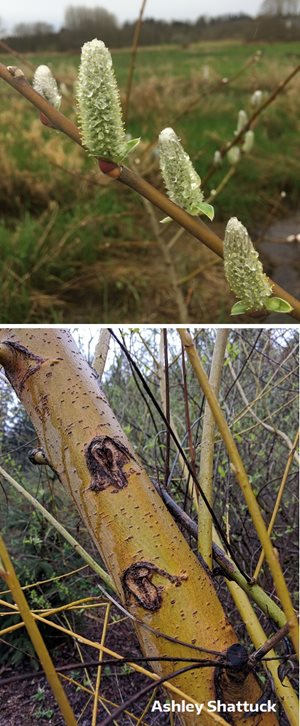Pacific Willow
Salix lasiandra spp. lasiandra – Pacific willow/Shining willow
formerly Salix lucida ssp. lasiandra

At a Glance:
- Family: Salicaceae
- Plant Type: large spreading multi-stemmed shrub/tree
- Distribution: Western North America, as far east as Montana and Colorado (this variety)
- Habitat: Moist areas, along rivers and streams, and wetlands
- Height: 15-45 feet tall
- Flowers/Fruits: drooping catkins. Males catkins are green to yellow, females are green/pale yellow. Once fruits develop, seeds are dispersed in the wind with fine, silky hairs (like cottonwood).
- Flowering Season: March- June
- Leaves: leathery/waxy dark green upper surface, with a lighter green, hairless underside. Leaf shapes are generally narrow and lanceolate with a pointed tip and a finely serrated margin.
- Generation: Perennial
- Bark: Mature bark is gray-brown and rugged, but new growth is often bright yellow, sometimes green.
- Notable feature: Pacific willow responds well to herbivory and fire, especially when beavers chew them down. After their main trunk is cut down, the tree will send up many trunks and become a multi-stemmed shrub.
Restoration and Conservation
Pacific willow is a cornerstone plant in PNW wetlands and provides many benefits to the environment in which they grow. The leaves are highly desired as browse by deer, American beavers, elk, and snowshoe hares. It provides habitat (either as dense shrub or as tall trees) for birds and small mammals. Beavers build dens and dams from the branches. Growing along streams, Pacific willows makes shade over water, cooling the water temperature and improving salmon habitat. Once the branches fall into the water, the woody debris provides habitat cover and creates deep pools for fish and other river animals.
This plant is a poster child for restoration projects in the PNW. Twigs can be cut and inserted into moist ground as live stakes. The twigs will regenerate into new established plants. These live stakes are very cost effective and grow rapidly. Pacific willow quickly creates a canopy and competes well with invasive plants like reed canarygrass. The bark and roots of our three campus willows assist other plants in establishing in new sites by acting as a rooting hormone.
Ethnobotany
Northwest native tribes used the branches and twigs to make hand drills to start fires, use as firewood, and make fish weirs and baskets. The leaves and branches were boiled down and used as a disinfectant. Willow bark is high in salicylic acid, the active ingredient in aspirin. Before aspirin was commercially made in a lab, willow bark was the main source for pain relief.
References and Resources
- Backyard Habits: https://backyardhabitats.org/wp-content/uploads/2018/10/Hardwood-Propagation-From-Cuttings.pdf
- FEIS/USDA: https://www.fs.fed.us/database/feis/plants/tree/salluc/all.html
- WTU Image Herbarium: http://biology.burke.washington.edu/herbarium/imagecollection/taxon.php?Taxon=Salix%20lasiandra
This article was written by Sarah Verlinde. For questions regarding the UWB/CC Plant Tour, contact Sarah at severlin@uw.edu.
